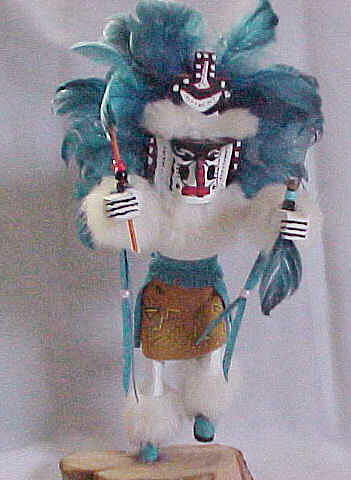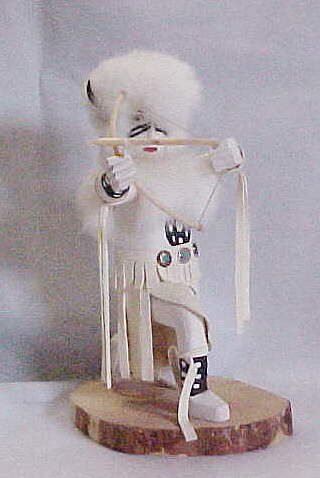 SANTA FE
MERCANTILE
SANTA FE
MERCANTILECLASSIC NATIVE AMERICAN hand crafted artwork. Here is the story of how the Kachina dolls began among the Hopi/Zuni people and how they continue today.
  |
The KACHINA DOLL was and still is made for native
use by HOPI fathers and uncles to give to their daughters or nieces. The doll
is hung on the wall or from the rafters of the house so that it may be seen at
all times. A Kachina teaches the child about MASK, COSTUME and BODY PAINTING.
Therefore the doll has to be as perfect as possible---especially the MASK. This
may explain why earlier dolls were accurate and detailed in the MASK, while the
BODY often had mere suggestions of arms and legs. The term "KACHINA" also refers to the MASKED DANCER in the PUEBLO VILLAGE; or, to the SPIRIT which the dancer interprets. Among the HOPI these SPIRITS are intermediaries between the man and the GODS. They can bring water, or the clouds from which the rain comes. Some tribes picture the KACHINAS as gathering above the clouds and tipping their great jars so the water falls upon the earth below. "KACHINA" also refers to a HOPI religion. All HOPI boys are introduced to the KACHINAS at the POWAMU CEREMONY, and thereafter they may perform in the KACHINA DANCES. Indeed, it is difficult to define "KACHINA." Although associated with the religion of the PUEBLOANS, the dolls are not religious objects or idols. The HOPI do not worship KACHINA DOLLS. PUEBLOAN groups believe that the KACHINAS live under lakes (ZUNI), or rivers, or on mountain tops (HOPI). The HOPI KACHINAS live on the SAN FRANCISCO PEAKS of northern Arizona or on other peaks for six months of the year. Then they live in the villages of this tribe for the remainder of the year. They appear in dances from the time of their arrival at the end of the initiation ceremony (the POWAMU) in late February to their return to the mountains at the NIMAN CEREMONY, or "HOME DANCE " in July. During their period of residence within the villages, they perform at various times in dance groups. The dancers are of course, HOPI men wearing MASKS and interpreting the SPIRITS. |